This article is more than 1 year old
The Life and Times of Lester Haines
Shed boffin, dad, sparks, punk rocker, wordsmith, pic-snapper, friend. We miss you
Obit "So what are going to say about him now that he’s gone? Are you going to say he was a good man? Will you be saying he was a happy man?... Fuck no."
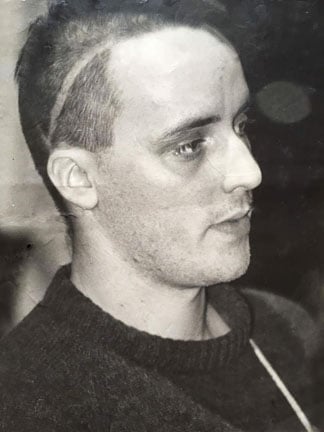
Lester Haines: 1960-2016
Lester Haines was born in London in September 1960, and was the eldest of five: he had three brothers and a sister.
He was named in honour of Lester Young, the American tenor saxophonist who played with the Count Basie Orchestra. Fittingly, for our Lester’s love of words, Lester Young was also the man who popularised use of the terms “cool” and “bread” (for money) and other jazz slang. The name was chosen by Lester’s father, Norman, a semi-professional jazz musician.
The family, brothers Ashley, Tim and Darryl, sister Natasha, mum Cathy, and Norman, moved to Kent when Lester was about four, first to Sittingbourne then to Faversham.
Tragically his youngest brother Darryl was knocked off his bike and killed when he was nine or ten, a huge trauma for the whole family.
Lester went to Borden Grammar School at 11 and quickly earned the irritation of the teachers. Younger brother Ashley said:
“When I started at the school, Lester’s reputation preceded me. On the first day the headmaster talked to our class and said: 'Some of you have siblings already at the school, I will be watching you...' and glanced in my direction.”
Lester bought his first guitar and amp in Woolworths and started his first band with brother Ashley - inspired by T-Rex, then in the charts, they were called Archaeopteryx.
Aside from playing the guitar he was also already obsessed by languages. At about 13 he heard that an ancient pre-Latin language, Etruscan, had never been properly translated. He took it upon himself to fix this gap in human knowledge this by spending several weeks going through books looking to trace the roots of different words.
More practically, by 15 Lester was teaching himself how to set up ring circuits and instal domestic wiring.
A cannabis-related incident at the school disco did little for Lester’s reputation for bad behaviour. Wrapping the school clock tower in a God Save the Queen banner didn’t help either.
He left school at 17 after a term of sixth form because he couldn’t stand the place any longer. Lester’s major creative outlet at this time was his band Nigel and the Ripsnorters, formed with Drew Cullen and Greg Palmer.
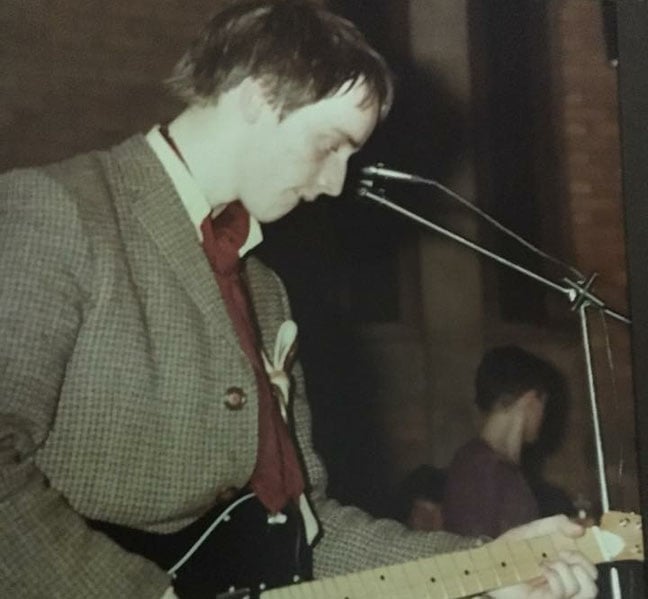
Lester playing guitar for Nigel and the Ripsnorters
Bandmate and lifelong friend Drew Cullen explained: “The Ripsnorters (as we became after a short time) were formed in the summer of 1977 - after O’ levels - Lester was the driving force at the beginning, my contribution was to come up with the cartoonish name. He asked me to be the singer because I always used to sing at school.
"We were punk in clothes and attitude - but the songs were tuneful and we were jolly and energetic on stage. There were three songwriters, Lester worked alone, while I wrote the words for music composed by Greg Palmer, the keyboard player. These days, Greg is a music director for theatres (I last saw him 15 or 16 years ago, but occasionally bump into his sister who has kept me updated.)
"The band had a shifting line-up, but the constant was me, Lester and Greg, although admittedly Lester left briefly - annoyed about something no doubt. We spent the first year mostly rehearsing. (We played in the church and then in Feb 1978 - I was already expelled from school - hired the town hall and put on a gig with another local band, called Cenet Rox, headlining. 180 people turned up.) The next two years we played about 60 gigs, including a couple of schools and four or five universities.
"I got the gigs and handled the money and we assembled a good following in our local area. (We did play the Marquee Club - but in the second round of a battle of the bands competition run by Melody Maker - a heavy rock band and the eventual winner Splodgeness Abounds got the final). We were doing quite well but in the end, people wanted different things and the band fell apart quietly and without fuss."
Aside from gigging success, the band’s main claim to fame, or at least notoriety, was playing a gig in a church when Rick the Vic, the Reverend Richard Mayes, was left in charge of a Southend Church. The errant vicar decided to get The Ripsnorters in to play a gig and havoc ensued. The tale got into the national press and became quite a scandal.
Drew explains their first meeting: “We met Rick in summer of 1977 because his motorbike broke down outside Lester’s house. He was trying to get to France for a short break. He spent several hours trying to fix the bike to no avail, so Lester went out and offered him a cup of tea - and then invited him to stay in his mother’s house.
"Rick looked like a biker and smoked marijuana - and it took some persuading for us to believe that he was a priest - a curate in Southend. He ended up staying at Lester’s and then at a friend’s house - where we were rehearsing - for a few days. He invited us to stay with him, never expecting that we would take up the offer. But Lester and I went to stay for a week at the end of August - and the rest of the band followed for a day or two, during which we played that gig.”
His brother Ashley remembers Lester even as a child being meticulous about everything he did. An early love of model building led to perfectly painted Airfix models all over his bedroom ceiling. His next passion of lepidoptery. He collected dozens of butterflies from the Kent countryside which were neatly arranged and labelled in a cabinet.
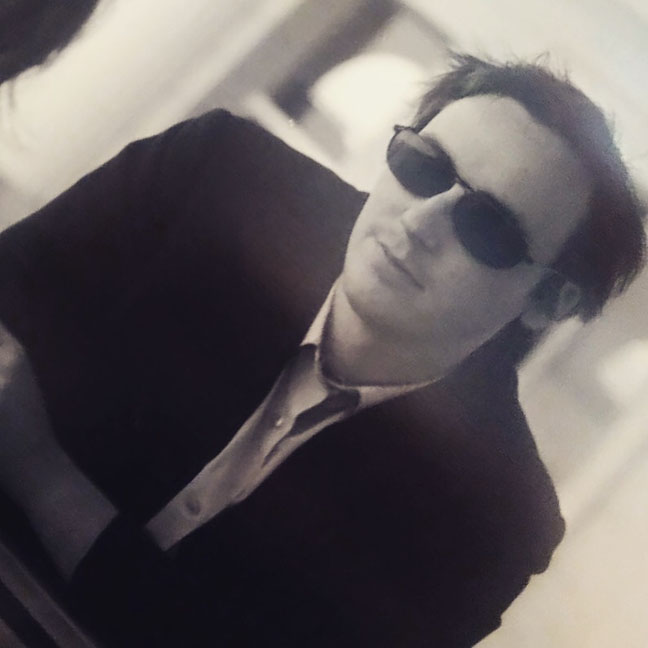
A snapshot from Lester's misspent amazingly industrious youth
He worked as an electrician for the short-life housing movement in London but never got formal qualifications. He had dozens of other skills too – he was a good carpenter and general builder as well as a photographer and video editor. He also worked as a photographer, cameraman, designer, director and editor. He ran music workshops for a kids charity in Haringey. Footage he filmed was used for the credit sequence for an early Mark Lamarr show, which paid the deposit on his first house in Manningtree, Essex.
He also directed pieces for comedian John Hegley in the early days of Cable London – for its short-lived community TV station. Lester had a love of language as it was spoken and used; he spoke Spanish and Portuguese fluently but always in his own way. He joined a Spanish class by chance when some friends were planning a trip to Mexico; they ended up dropping the class but Lester persevered. He got an O level, followed by an A level which led to the course at King’s College London.
Adventures in language
Lucy Phillips, a friend from King's, where they both read Hispanic Studies in the 1990s, said: “Lester put some people’s noses out of joint because he was highly intelligent and completely unpretentious. He was great at translating because he focused on how language was really used. We were a small and slightly odd group of students. There were about 20 or 30 of us, about half were mature students, one guy was in his 70s, some were native Spanish speakers and one was an ex-ambassador’s wife. So Lester really stood out and put the backs up of the more conventional students. His use of words and language was amazing.
"We used to drink around Aldwych and the Strand, where King’s is, and in the Archway Tavern when Lester was living in Kentish Town. He was bright and funny but could be spiky too – I’m sure we fell out a few times over minor issues – he would not bend. I think it was only him and me that got Firsts that year. We also worked together translating an Argentinian play and were involved in the very first UK performance of a Lorca play – The Public.
"Lester did photography for the poster. He had all these skills, I don’t know where he learnt them all. He knew about photography in the days before digital but also video editing – I did the voice-over for this film about the Devil’s Railway. We recorded it in a house in Brixton with planes going overhead and me mangling the Portuguese place names.”
The Devil’s Railway was an ill-fated nineteenth century project to build a railway to transport Bolivian rubber to the Atlantic coast. After several abandoned attempts which cost millions of dollars and thousands of lives it opened in 1912, just as the rubber boom collapsed. Lester chose to research the subject for his dissertation. "
Professor David Treece, head of Spanish, Portuguese and Hispanic Studies at King’s, said: “Lester got a First in Portuguese, Spanish and Latin American Studies (1994), and among other things, his strong interests and highest marks were in Spanish Language and Linguistics. But a real highlight for me of his work on the Portuguese side was the research project and dissertation he did (also First Class) on '"The Devil's Railway": The Construction of the Madeira-Mamoré Railway'.
"It was a really original project on the Fitzcarraldo-like story of the bridging of two Amazonian rivers with a railway project completed in 1907-12, and now long since abandoned, with enormous cost to human life (some estimates put the number of workers who died throughout the construction at over 30,000). Lester was fascinated and passionate about the story.”
Adventures in The Darién Gap
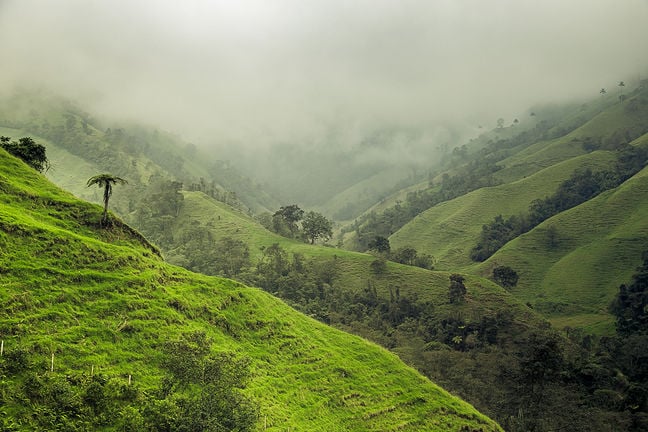
So is it two valleys to the left, then up to the river, or..? "The Gap" – complete with disagreeable wildlife; soggy swampland; pretty valleys; drug runners; bored, armed guerrillas; cops; kidnappers;... oh, and little to no markings or signage...
He filmed footage in Brazil to include in the film which he used to present his research to the university instead of the more conventional essay. He always loved a romantic and slightly absurd adventure – after graduating he tried to cross the Darién Gap with his brother Ashley. You can drive from Canada to the tip of South America except for a 50-mile stretch of jungle, rivers and bandits between Panama and Colombia.
It remains a mostly inaccessible and dangerous region even today.
Where in the world is Lester?
Barry Hale shared a house with Lester at this time: "What shape would chairs be if our knees bent the other way?" This was one of the many philosophical debates I had with Lester over the six months I shared a house with him. It was 1995."I'd just finished my masters up at Leeds Film School and was looking to move back to London. I was introduced to Lester by a mutual friend and within an hour of meeting we'd worked out a pitch for a short film based on the Pamplona bull run, the murder of Andalusian poet Federico Garcia Lorca and Roman religious practices in Spain. Two weeks later I'd moved in. We shared a passion for Spanish culture, film and the absurd. It was a time of limited funds but great creativity. Lester was already deep in preparations for his Darién Gap adventure.
"I assisted him with the sponsorship letters, getting massive discounts on camping gear and huge machetes.
"I remember the day we saw [Lester's son] Rui dressed up in the identikit jungle gear and hat to match what his dad would be wearing for the trip into the jungles of Panama. We worked together on a couple of pitches for documentaries and we lugged an Apple Mac half-way across London to mock up the covers for a proposed new magazine, provisionally titled Gear Monthly.
"We wrote sketches too, getting obsessed with a quarry that seemed to appear in all British TV series of the seventies. We wrote a scenario where 100 Daleks were queuing for the catering truck only to discover to their horror and dismay that one Dalek in their midst was vegetarian. Six months later Lester had returned from his Darién Gap adventure and I'd moved back to the Midlands to set up the company I've now been running for 20 years.
"I followed Lester's crazy adventures online - his reclaiming of Rockall, the first paper aeroplane launched from space and of course his writing. It was a tough time but we had laughs aplenty and that's what I'll always remember him for: his ambition, his imagination, his can-do attitude and his wit. Much missed. Much loved.”
Lester’s attempt to cross the Darién Gap, known to be one of the most dangerous routes in the world, was a typical Quixotic quest – in his words: "It’s got to be done."
At Lester’s prompting, Ashley, and two of Lester’s mates, set off to Panama to cross the Gap. Lester’s Spanish was good enough to overhear that many of people offering to help them were really planning on robbing them.
Finally they met an ex-US GI called Todd and with some honest helpers set off into the jungle for what was expected to be a week or two week journey into Colombia. Lester lasted a day and a half – lack of fitness and too much smoking plus the onset of malaria sent him back to town.
Amazingly, Ashley and Todd, with the help of an Indian guide, got as far as a Panamanian army camp, usually reached by helicopter, overlooking the Colombian border. When they got back, Lester had been forced home to sort out his malaria. He ended up in the London Hospital for Tropical Medicine with a never-identified illness.
Other trips included Cuba and Nicaragua to document the Sandinistas. He used his photography to help fund these trips selling postcards and calendars of his pictures.
Lester in the theatre
Lester returned to London and after a chance meeting with Mary East, they started The Mombasa Roadshow – an alternative theatre group which used amateur casts to put on classic plays from 1981 until 1991. Lester designed posters and co-directed plays as well as appearing in some productions. Mary East is a community theatre pioneer and one of the founders of Hull Truck theatre, she met Lester shortly after performing Future Shock to rave reviews at the Edinburgh Fringe and while waiting for its run at the Roundhouse.
They met at a party in a West Hampstead Housing Association house.
Mary said: “It was during Peter O’Toole’s [famously awful] performance of Macbeth in 1980 and Lester decided he could do a better job. He wanted to produce it but was not quite clear on the difference between producing and directing. I got involved as the only person who had any stage experience. They were a random collection of builders from the housing association and assorted other musicians and punks who used to meet in Rosie’s Cafe in Kilburn.
"We got £100 for the first performance at the Carlton Community Centre in Kilburn. There would be a play and two bands – The Ripsnorters played. Lester and I co-directed, he had a fantastic imagination and we just really gelled. The whole thing just caught fire, it was amazing. Macbeth was fantastic. Then we did Titus Andronicus on a £200 budget for five nights.
"The actors made their own armour lashed together with electrical wire. Lester got some catheters for the blood special effects and wanted to spray the audience with blood. The trouble was they tried it out in the gents and blood went everywhere. I went in the next day and was told the cleaner had fainted at the sight having assumed someone had died. They were absolutely furious and we were banned from performing there again.
"Our theory was that theatre should be like football - 45 minutes each way, with extra time in the second half if it was really good. Lester was a fantastic moving spirit and The Mombasa Roadshow was so important for so many people. It got people out of bed and off drugs for rehearsals. It gave lots of people a jumping off point and a start. It was that just do it ethos which is so important.”
The two fell out over Bartholomew Fair but peace was restored for later productions.
Punk legends King Kurt were big fans and played one of the shows. Mary was also the link which got Lester involved with the short-life housing movement.
Helen Moore was involved in the short-life housing and squatting scene in North London with Lester. She was in Titus Andronicus – Lester had a walk-on part to collect the severed heads. She said: “He was frustrating but you could not deny his brilliance, he always made us laugh.”
Lester and Drew Cullen also wrote a series of Dada sketch shows and Lester co-wrote a pantomime: Oh no, not the janitor. The final show Moore remembers was The White Devil performed in the Diorama in Regent’s Park, Lester used his construction skills to build the stage as well as helping with direction and art design.
Geoff Sample remembers the theatre work: “Lester was very much involved in the Mombasa in the first phase. He may have acted in Titus Andronicus and Bartholomew Fair, or co-directed with Mary East.
"He did design the White Devil poster.
“There were also a couple of sketch shows we did, the first of which, the Dada show, was very much Lester’s infusion. I remember him most for this, since this was my first involvement and my role was his idea. I sat at the side of the stage all the way through, reading the paper and drinking beer, while various weird and daft scenes came and went.
"I think someone brought me some fish and chips at one point.
"Towards the end a samurai warrior in full regalia ceremonially beheads a cabbage front of stage. After which I get up, go to front of stage, and deliver my only lines despite being on stage all the way through. ‘So what are going to say about him now that he’s gone? Are you going to say he was a good man? Will you be saying he was a happy man? ... Fuck no.’
"Well that’s how I remember it. Lester’s lines and great to deliver (in context!).
He also used his electrical and other building skills to make short-life housing and squats habitable. Lester then survived on a portfolio of different jobs – photographer, contributor and editor for Practical Woodworking, hidden camera work with Donal MacIntyre’s early investigative TV shows including the Chelsea Headhunters episode, translating, designing and editing.
The Register
Lester started working at The Register in 2000, initially in charge of merchandising. But along with creating T-shirts he soon started writing. He was perhaps the most community-minded of the regular Reg staffers. In the olden days he edited the weekly letters piece and later waded in to deal with misbehaving commentards.
Although occasionally irritated by wails of “Where’s the IT angle”, he had a lot of affection for his readers. He probably empathised with the rather barbed nature of many Reg readers, who have little time for pomposity or ignorance.
Particularly poisonous missives would be awarded “Flame of the Week” in what quickly became a cult column.
He had several pet projects which played a big role in creating the personality of the site. He was an early advocate of the Google Earth and Google Street View stories, often spotted by readers.
He also recorded the worst excesses of the strategy boutiques with regular LogoWatch stories. The Office of Government Commerce is possibly the finest example (see here).
Realising his daughter Kati had an almost inexhaustible appetite for PlayMobil toys he also pioneered the PlayMobil recreation of news events, allowing him to keep his daughter happy on expenses. He warned readers about the increasing danger posed by the Rise of the Machines to meat-based humanity.
His last series was the post-pub nosh slot, which saw him recreating gastronomic horrors suggested by readers – with the help of his children and friends.
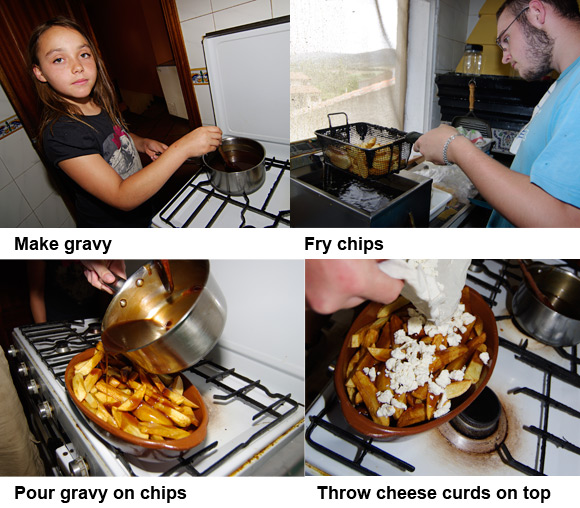
Lester's children Rui and Katarina help create a poutine. Pic: Lester Haines
The Rockall Times
A notable side-project was The Rockall Times – a satirical site launched in 2001. This began, as do all the best ideas, in the pub.
The discussion began as a contest to image the world’s worst possible local newspaper. In the end the title The Rockall Times was chosen. The paper would have the strapline – ‘There’s fuckall on Rockall’.
The launch release for the website outlined the plan:
Powered by Yeast Logic, The Rockall Times is the brainchild of two young guns not yet known to the world of media celebrity, Lester Haines and Kieren McCarthy. Haines, one time editor of leading hobby and tool magazine, Professional Woodworking, says: "The Rockall Times reflects the very best of what being British is all about. We want to take Rockall out of the shipping news and into the consciousness of the great unwashed British public. It's high time someone upped the stakes of satire, there is far too much bollocks being printed in the British press especially around the current War on Terror...A key objective for The Rockall Times will be to expose to ridicule and lambastation all lies, pomposity, disinformation, arrogance and pretentiousness wherever and whenever they occur.
Yeast Logic - the kind of thinking which makes perfect sense in the pub but only Lester would attempt to follow through - led to an attempt to land on the rock itself. At over 460km (290 miles) from the UK coast and rising vertically from the Atlantic this was a serious challenge.
The rock is reputed to have welcomed fewer human visitors than the moon and most of those have been lowered from a helicopter. The first attempt had to be abandoned due to rough weather.
Undeterred, Lester returned two years later...in a bigger boat. This time the weather was better and he scrambled onto the rock, along with fellow expedition members led by Al Baker, a veteran of Greenpeace's "Waveland" occupation of Rockall in 1997. You can find Lester's name on The Rockall Club's Honour Roll, which contains all the named individuals who are recognised as landing on the rock.

This is not meant to be a eulogy and the end of the Rockall Times revealed several of Lester’s less lovely attributes. He could start an argument in a lift, never mind in a small boat in the Atlantic. He could get absurdly and self-defeatingly angry. He was sacked at least twice from The Register and resigned or threatened to quit even more frequently. He was hopeless with money. He had difficult relationships with women and a series of fallings-out with people from which he would never back down. In the last few years he took a wilful disregard for his health to absurd lengths and refused to acknowledge the damage he was doing.
But on his day he was fantastic and hilarious company, with a width and depth of knowledge and enthusiasms that continued to surprise. He was kind, generous and funny with an unerring ear and eye for pomposity.
He had never mentioned his theatrical past until walking past the London Eye one afternoon he told me he’d played Bottom in a production of Midsummer Night’s Dream with the designer of the Eye, Julia Barfield, playing Titania.
He could talk at length on the merits of dimmable LED light fittings, the innate superiority of the two-piece toilet, on nineteenth century British naval history – he named his house in Spain Temeraire and was disgusted that I needed to have the name explained to me.
In about 2003 he moved with his wife Claudete and daughter Katarina to Spain. He enjoyed reminding his Spanish neighbours how many Spanish ships Nelson had sunk at Trafalgar. He traded his house in Essex for several run-down properties in the mountains west of Madrid.
When not writing for The Reg, he was busy putting his myriad other talents to work restoring them with help from his son Rui, various nephews and anyone else he could rope in.
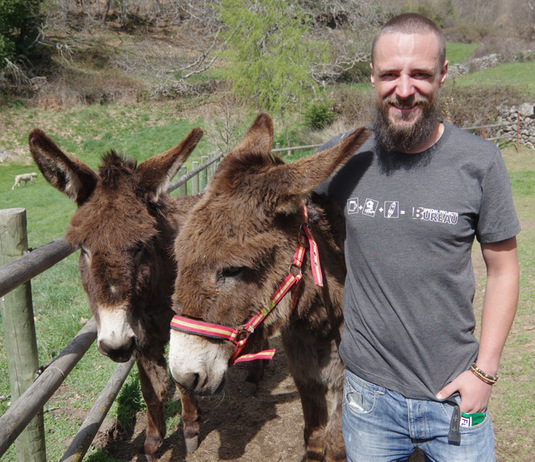
Matthew Haines, Lester's nephew, with Ruperta and Banksy
Lester lived in the tiny village of Los Narros with two donkeys, Ruperta and Banksy, and five adopted stray dogs – the mutts. There were about six permanent human residents although the population was boosted by weekend and summer visitors. He described it as "the centre of the universe".
There’s a great interview with him, in Spanish, on national TV broadcaster RTVE, here.
Nearby is Navatejares with its bastion of civilisation – Tito’s Bar. It is run by Tito and Yolanda, friends of Lester’s, who also provided a well-stocked headquarters for the PARIS launch.
Another good friend, Jose Maria Pita, recalls meeting Lester for the first time: "About fourteen or fifteen years have passed since the beginning of times, when I decided to stop business and travelling, leave Madrid and work comfortably from a beautiful place in the Sierra de Gredos. I just needed an internet connection, a fireplace and a box of beers. That was exactly the same idea as an Englishman I found one morning, in the back of a 'cybercafé', hooked to a computer.
"He did not move, he typed. He did not drink, he did not speak. He only worked. A couple of computers further away I settled and for a while I worked until I got up to try the 'Rioja' of the house. The 'maldito inglés' was still typing, until he finally had coffee with me. I repeat: a coffee!
"Soon we both came to the conclusion that our faith in the Spanish bureaucracy was oversized: the fifteen days we were promised to have a telephone line and the internet at home were changing into months. We compensated with the feeling that working in a bar was something enviable, out of the reach of ordinary mortals, except for the waiters.
"During all these years, Lester and I have shared very funny moments, also a lot of work and projects, many beers, barbecues, and some fights against the local 'cowboys' (this toll is essential when one decides to live in the 'centre of the universe' and the others consider that it is his exclusive property).
Until one afternoon, last June, when I went to Los Narros, I knocked on the door and Lester did not answer. The 'maldito inglés' had left without warning. Lester has been one of the few great friends that I have had the immense fortune to enjoy in this life."
PARIS: Paper Aircraft Released Into Space
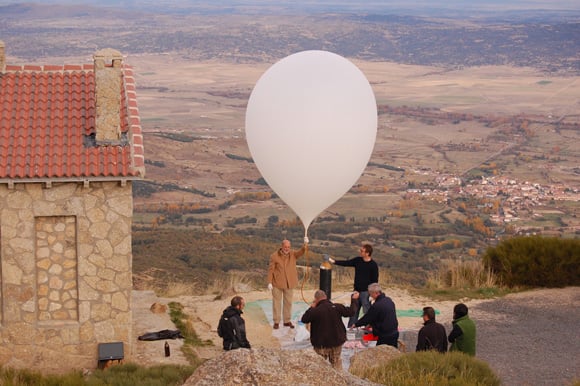
John Oates and Lester at the PARIS launch
The Lester scheme I was most closely involved with was PARIS – Paper Aeroplane Released In Space. The idea was sparked by a reader comment and Lester initially thought that building the model would keep his fingers warm during the Spanish winter – the village he lived in the mountains about Avila regularly saw several feet of snow leaving residents cut off for weeks at a time.
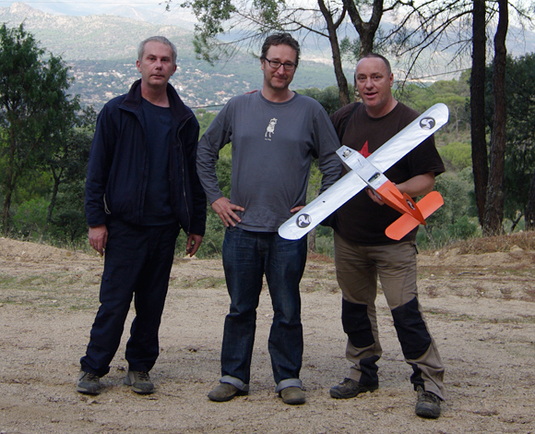
Steve Daniels, John and Lester recover PARIS from her perch. Pic: Federico Buenadicha
He was a man at his best in the depths of a project. Lester had kept the story going for well over a year, with constant updates on the model building, making and testing of the various components.
The release mechanism was tested in a hypobaric chamber in Qinetiq’s labs near Farnborough. By the time radio ham Steve Daniels and I arrived in Spain, expectations for the launch were seriously high. Which was worrying because on arriving back at Navatejares Lester admitted he had plenty of helium but no balloon.
The parachute had also not arrived – Spanish customs had seized it and we suspected were trying to work out what the hell the right import duty was for a space parachute. Lester was adamant that the launch would go-ahead although this was clearly impossible with no weather balloon. We distracted ourselves with other matters.
Tito and Yolanda provided food and operations headquarters at their bar. Jose Maria Pita provided a case of wine and emotional and intellectual support. From our first trip to the nearby town it was clear that absolutely everyone knew about the scheme. Everywhere we went people wished us luck and asked for updates.
We found a local seamstress who agreed to stitch up a parachute out of the rayon cloth we’d procured from a dressmaker in the next village. Lester promised her fame on the internet, she agreed to make the parachute only on the understanding that we told absolutely no-one. We blamed the first delay on dodgy weather and stayed in praying for the postman to bring the balloon.
I think we blamed the second delay on the van breaking down – which it did, but we still had no balloon. We drank and wondered how the hell we were going to launch without a balloon. Party balloons? Dozens of bin bags? Thousands of condoms? A tent? By some miracle the balloon arrived the following Wednesday, meaning we could launch on Thursday before flying out on Friday.
The launch went absurdly smoothly, thanks to Lester’s detailed planning and preparation. As balloon, launch capsule and plane floated out of sight we all felt an enormous sense of relief that we’d got rid of the bloody thing. I’m not sure any of us believed we would ever see either the plane or the launch module again.
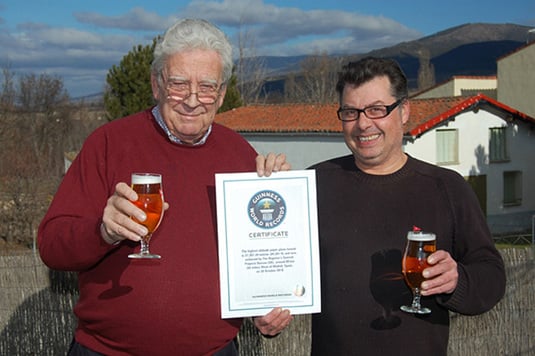
Jose Maria and Tito with the Guinness World Record certificate
The paper plane and its PlayMobil pilot reached just short of 90,000 feet and got Lester a Guinness World Record. Somehow after a 100 mile chase we managed to find both the launch module and the plane. Most people would have regarded the lack of a launch balloon as the end of the project but Lester’s bloody-mindedness, helped by the Spanish postal service, got us to launch.
LOHAN: Low Orbit Helium Assisted Navigator
His next project Vulture 2, or LOHAN (Low Orbit Helium Assisted Navigator), – for a rocket-powered, balloon-assisted space plane proved a tougher nut to crack. It had all the existing difficulties of PARIS with the addition of actual rocket science, and an entire new world of regulation.
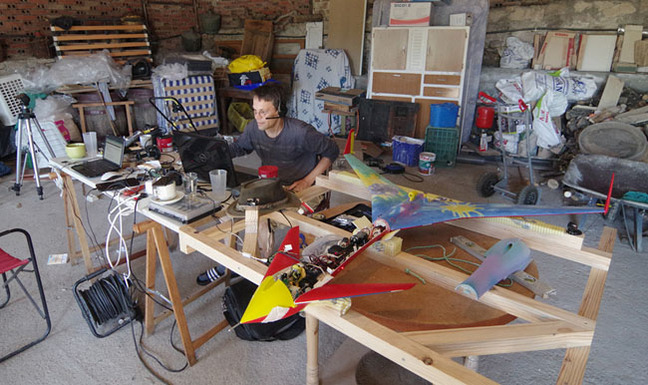
Spaceplane autopilot wrangler Linus Penzlien with LOHAN.
With the help of reader volunteers, and hundreds of Kickstarter contributions, LOHAN made real progress but sadly Lester was not to see it fly into the record books. He did come up with a cracking motto though.
The LOHAN project continued and Lester continued to run the Special Projects Bureau covering space, drones, vultures and anything else that took his fancy.
Farewell
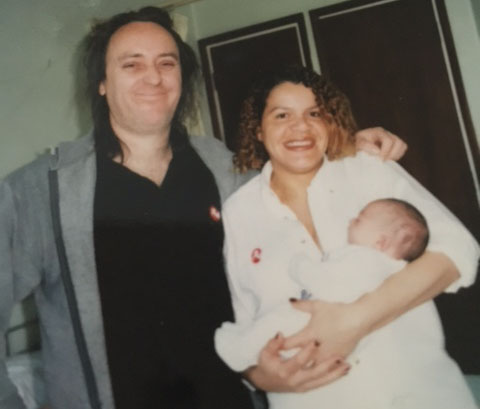
Lester with Claudete and Katarina.
His death from a heart attack at 55 was a shock although many people close to him had tried to get him to take better care of himself. He lived life at full tilt and never did anything half-heartedly.
He was intelligent, restless and hugely creative - rest in peace would be the worst possible epitaph.
He brought a lot of happiness, and a degree of irritation, to an awful lot of people. Lester is survived by his partner Claudete and two children – Rui and Katarina – he was fiercely proud of both of them. ®
